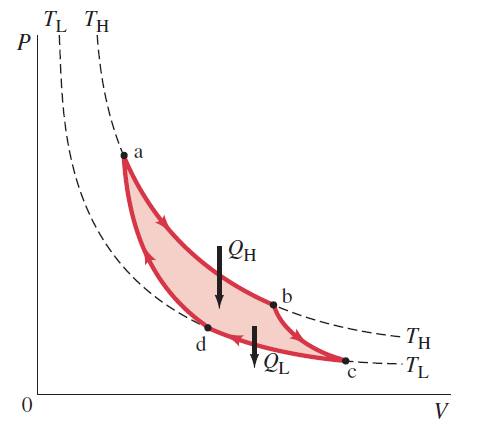Thermodynamics: Carnot Engine
- Mole
- Gas Volume
- States of Matter
- Heat
- Enthalpy
- Thermodynamics
- Adiabatic Process
- Mass Energy Conservation
- Carnot Engine 🢀
Introduction
The French scientist Sadi Carnot (1796–1832) proposed a theoretical engine, now called a Carnot engine, to study the process of transforming heat into work. Although a Carnot engine does not exits it gives us upper limits for efficiency of all heat engines. The Carnot engine can be imagined as a simple cylinder/piston system that operates cyclically between the states a, b, c, d, a.

Step 1: isothermal expansion a → b
The gas is expanded isothermally with the addition of heat along the path a → b at temperature $T_H$. (All temperatures are in Kelvin.) The machine generates the work (ideal gas assumed): $$ W_1 = \int _{a}^{b} p dV = \int _{a}^{b} \frac{n R T_H}{V} dV = n R T_H \ln \frac{V_b}{V_a} \tag{1} $$ The First Law of thermodynamics implies: $$ W_1 = Q_H - \Delta U = Q_H \;(\ge 0) \tag{2} $$ i.e. the whole amount of supplied heat is transformed into work.
Step 2: adiabatic expansion b → c
The gas is expanded adiabatically ($Q = 0$) along the path b → c from temperature $T_H$ to temperature $T_L$. The machine generates the work ($U$ is the inner energy, $C_v$ is specific heat at constant volume)):
Step 3: isothermal compression c → d
The gas is compressed isothermally with rejection of heat along the path c → d at temperature $T_L$. The machine consumes the work (ideal gas assumed): $$ W_3 = \int _{c}^{d} p dV = \int _{c}^{d} \frac{n R T_L}{V} dV = n R T_L \ln \frac{V_d}{V_c} \tag{4} $$ The First Law of thermodynamics implies: $$ W_3 = Q_L - \Delta U = Q_L \;(\le 0) \tag{5} $$
Step 4: adiabatic compression d → a
The gas is compressed adiabatically ($Q = 0$) along the path d → a from temperature $T_L$ to temperature $T_H$. The machine consumes the work ($U$ is the inner energy, $C_v$ is specific heat at constant volume):
Cycle
The total generated work along the cycle is the sum of the $W_i$. Notice that $W_4 = - W_2$. Take also into account that the steps b → c and d → a are adiabatic processes such that:
$$\begin{align} T_H ^{1-γ} V_b & = T_L ^{1-γ} V_c \tag {7a} \\ T_H ^{1-γ} V_a & = T_L ^{1-γ} V_d \tag {7b} \end{align}$$Dividing Eq.(7a) by Eq.(7b) we get:
$$ \frac{V_b}{V_a} = \frac{V_c}{V_d} \tag {8} $$Substituting Eq. (8) into Eq. (4) we obtain: $$ W_3 = - n R T_H \ln \frac{V_b}{V_a} \tag{9} $$ Finally, the total produced work of the cycle is: $$ W = W_1 + W_2 + W_3 + W_4 = n R T_L \ln \frac{V_b}{V_a} (T_H - T_L) \tag{10} $$
Th efficiency of a thermodynamical process is defined as: $$ η = \frac{\text{what we get}}{\text{what we pay}} \tag{11} $$ We get the total work $W$ in Eq. (10) and we pay with the supplied heat $Q_H = W_1$ in the first step (Eq.(2)). Substituting the respective equations we obtain the efficiency of the Carnot engine: $$ η = \frac{W}{W_1} = \frac{T_H - T_L}{T_H} = 1 - \frac{T_L}{T_H} \;(\lt 1) \tag{12} $$ The efficiency ist stricly less than 1 because the temperature of absolute zero (0 Kelvin) cannot be achieved.
We can also use the Eqs. (2) and (5) to get (notice that $Q_L \lt 0$): $$ η = \frac{W_1 + W_3}{W_1} = \frac{Q_H + Q_L}{Q_H} = 1 + \frac{Q_L}{Q_H} \;(\lt 1) \tag{13} $$
Carnot Theorem
Any system working between two given temperatures $T_{H}$ (hot reservoir) and $T_{L}$ (cold reservoir), can never have a greater efficiency than the Carnot engine working between the same reservoirs. This efficiency is stricly less than 1 and is given by: $$ η = 1 - \frac{T_L}{T_H} = 1 + \frac{Q_L}{Q_H} \tag{14} $$
